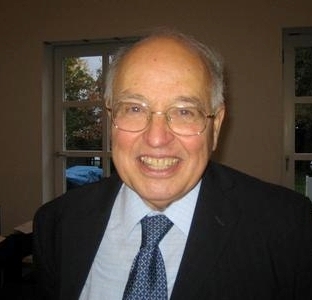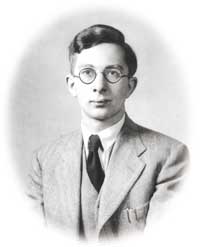Related Research Articles

Sir Michael Francis Atiyah was a British-Lebanese mathematician specialising in geometry. His contributions include the Atiyah–Singer index theorem and co-founding topological K-theory. He was awarded the Fields Medal in 1966 and the Abel Prize in 2004.

In mathematics and physics, a soliton is a nonlinear, self-reinforcing, localized wave packet that is strongly stable, in that it preserves its shape while propagating freely, at constant velocity, and recovers it even after collisions with other such localized wave packets. Its remarkable stability can be traced to a balanced cancellation of nonlinear and dispersive effects in the medium. Solitons were subsequently found to provide stable solutions of a wide class of weakly nonlinear dispersive partial differential equations describing physical systems.
In mathematics and physics, solitons, topological solitons and topological defects are three closely related ideas, all of which signify structures in a physical system that are stable against perturbations. Solitons won't decay, dissipate, disperse or evaporate in the way that ordinary waves might. The stability arises from an obstruction to the decay, which is explained by having the soliton belong to a different topological homotopy class or cohomology class than the base physical system. More simply: it is not possible to continuously transform the system with a soliton in it, to one without it. The mathematics behind topological stability is both deep and broad, and a vast variety of systems possessing topological stability have been described. This makes categorization somewhat difficult.
In particle theory, the skyrmion is a topologically stable field configuration of a certain class of non-linear sigma models. It was originally proposed as a model of the nucleon by Tony Skyrme in 1961. As a topological soliton in the pion field, it has the remarkable property of being able to model, with reasonable accuracy, multiple low-energy properties of the nucleon, simply by fixing the nucleon radius. It has since found application in solid-state physics, as well as having ties to certain areas of string theory.
David George Crighton, FRS was a British mathematician and physicist.
Montonen–Olive duality or electric–magnetic duality is the oldest known example of strong–weak duality or S-duality according to current terminology. It generalizes the electro-magnetic symmetry of Maxwell's equations by stating that magnetic monopoles, which are usually viewed as emergent quasiparticles that are "composite", can in fact be viewed as "elementary" quantized particles with electrons playing the reverse role of "composite" topological solitons; the viewpoints are equivalent and the situation dependent on the duality. It was later proven to hold true when dealing with a N = 4 supersymmetric Yang–Mills theory. It is named after Finnish physicist Claus Montonen and British physicist David Olive after they proposed the idea in their academic paper Magnetic monopoles as gauge particles? where they state:
There should be two "dual equivalent" field formulations of the same theory in which electric (Noether) and magnetic (topological) quantum numbers exchange roles.

Tony Hilton Royle Skyrme was a British physicist who was born in Lewisham.

David James Thouless was a British condensed-matter physicist. He was the winner of the 1990 Wolf Prize and a laureate of the 2016 Nobel Prize for physics along with F. Duncan M. Haldane and J. Michael Kosterlitz for theoretical discoveries of topological phase transitions and topological phases of matter.
Richard Samuel Ward FRS is a British mathematical physicist. He is a Professor of Mathematical & Theoretical Particle Physics at the University of Durham.
Paul Michael Sutcliffe is British mathematical physicist and mathematician, currently Professor of Theoretical Physics at the University of Durham. He specialises in the study of topological solitons.

Nicholas Kemmer was a Russian-born nuclear physicist working in Britain, who played an integral and leading edge role in United Kingdom's nuclear programme, and was known as a mentor of Abdus Salam – a Nobel laureate in physics.

David Ian Olive ; 16 April 1937 – 7 November 2012) was a British theoretical physicist. Olive made fundamental contributions to string theory and duality theory, he is particularly known for his work on the GSO projection and Montonen–Olive duality.
John Lawrence CardyFRS is a British–American theoretical physicist. He is best known for his work in theoretical condensed matter physics and statistical mechanics, and in particular for research on critical phenomena and two-dimensional conformal field theory.

Werner Nahm is a German theoretical physicist. He has made contributions to mathematical physics and fundamental theoretical physics.

In physics, magnetic skyrmions are statically stable solitons which have been predicted theoretically and observed experimentally in condensed matter systems. Magnetic skyrmions can be formed in magnetic materials in their 'bulk' such as in manganese monosilicide (MnSi), or in magnetic thin films. They can be achiral, or chiral in nature, and may exist both as dynamic excitations or stable or metastable states. Although the broad lines defining magnetic skyrmions have been established de facto, there exist a variety of interpretations with subtle differences.
Bryan Ronald Webber, FRS, FInstP is a British physicist and academic. He was a Fellow of Emmanuel College, Cambridge from 1973 to 2010, and Professor of Theoretical Physics at the University of Cambridge from 1999 to 2010. He has been awarded the Dirac Medal by the Institute of Physics, the Sakurai Prize by the American Physical Society and the High Energy and Particle Physics Prize by the European Physical Society.
John Clayton Taylor is a British mathematical physicist. He is an Emeritus Professor of Mathematical Physics at the Department of Applied Mathematics and Theoretical Physics of the University of Cambridge and an Emeritus Fellow of Robinson College. He is the father of mathematician Richard Taylor.
Richard Battye is a cosmologist, theoretical physicist and former first-class cricketer. He is currently a Professor of Cosmology at the University of Manchester and has been the associate director (science) in the Jodrell Bank Centre for Astrophysics since 2015.
Olaf Lechtenfeld is a German mathematical physicist, academic and researcher. He is a full professor at the Institute of Theoretical Physics at Leibniz University, where he founded the Riemann Center for Geometry and Physics.
Larry D. McLerran is an American physicist and an academic. He is a professor of physics at the University of Washington.
References
- 1 2 Nicholas Manton at the Mathematics Genealogy Project
- ↑ Autobiographical Memoir, p.7
- 1 2 3 "Nicholas Manton". London: Royal Society. One or more of the preceding sentences may incorporate text from the royalsociety.org website where "all text published under the heading 'Biography' on Fellow profile pages is available under Creative Commons Attribution 4.0 International License." "Royal Society Terms, conditions and policies". Archived from the original on 20 February 2016. Retrieved 9 March 2016.
{{cite web}}: CS1 maint: bot: original URL status unknown (link) - ↑ Professor Nicholas Manton, University of Cambridge, retrieved 2016-03-10.